Key Parameters of Gob-Side Entry Retaining in A Gassy and Thin Coal Seam with Hard Roof
Abstract
:1. Introduction
2. Materials and Methods
2.1. GER Techniques in a Thin Coal Seam (TCS) with a Limestone Roof (LR)
- (1)
- Gas concentration in gob
- (2)
- Contour of air pressure in the gob
2.2. Mechanical Model for GER-TCS-LR
- (1)
- Roof-cutting resistance of the RBB
- (2)
- The width of the RBB
3. Determination of RBB Width
3.1. Mining and Geological Conditions of the Tested Roadway
3.2. Determination of the Roof-Cutting Resistance of the RBB
3.3. Determination of the RBB Width
3.3.1. Numerical Model
3.3.2. Results and Discussion
- (1)
- Convergence of GER with respect to RBB width
- (2)
- Stress distribution around the GER with respect to RBB width
4. Field Test and Field Monitoring
5. Conclusions
Author Contributions
Acknowledgments
Conflicts of Interest
References
- Wang, D. Study on Integrated Assessment and Regulation Policies of Coal Production Capacity in China; China University of Mining and Technology Press: Xuzhou, China, 2013; pp. 12–16. [Google Scholar]
- Huang, N.; Jiang, Y.; Li, B.; Liu, R. A numerical method for simulating fluid flow through 3-D fracture networks. J. Nat. Gas Sci. Eng. 2016, 33, 1271–1281. [Google Scholar] [CrossRef]
- Deng, Y.; Wang, S. Feasibility analysis of gob-side entry retaining on a working face in a steep coal seam. Int. J. Min. Sci. Technol. 2014, 24, 499–503. [Google Scholar] [CrossRef]
- Yang, H.; Cao, S.; Li, Y.; Sun, C.; Guo, P. Soft Roof Failure Mechanism and Supporting Method for Gob-Side Entry Retaining. Minerals 2015, 5, 707–722. [Google Scholar] [CrossRef]
- Zhang, Z.Y.; Hideki, S.; Qian, D.Y.; Takashi, S. Application of the retained gob-side gateroad in a deep underground coalmine. Int. J. Min. Reclam. Environ. 2016, 30, 371–389. [Google Scholar] [CrossRef]
- Lu, S. Strata Behaviors of Entry without Chain Pillar; China Coal Industry Press: Beijing, China, 1982; pp. 1–2. [Google Scholar]
- Tan, Y.L.; Yu, F.H.; Ning, J.G.; Zhao, T.B. Design and construction of entry retaining wall along a gob side under hard roof stratum. Int. J. Rock Mech. Min. Sci. 2015, 77, 115–121. [Google Scholar] [CrossRef]
- Huang, Y.L.; Li, J.M.; Song, T.Q.; Kong, G.Q.; Li, M. Analysis on Filling Ratio and Shield Supporting Pressure for Overburden Movement Control in Coal Mining with Compacted Backfilling. Energies 2017, 10, 31. [Google Scholar] [CrossRef]
- Jiang, H.; Miao, X.; Zhang, J.; Liu, S. Gateside packwall design in solid backfill mining-A case study. Int. J. Min. Sci. Technol. 2016, 26, 261–265. [Google Scholar] [CrossRef]
- Hidalgo, K.P.; Nordlund, E. Failure process analysis of spalling failure-Comparison of laboratory test and numerical modelling data. Tunn. Undergr. Space Technol. 2012, 32, 66–77. [Google Scholar] [CrossRef]
- Villaescusa, E.; Varden, R.; Hassell, R. Quantifying the performance of resin anchored rock bolts in the Australian underground hard rock mining industry. Int. J. Rock Mech. Min. Sci. 2008, 45, 94–102. [Google Scholar] [CrossRef]
- Sun, X.M.; Liu, X.; Liang, G.F.; Wang, D.; Jiang, Y.L. Key parameters of gob-side entry retaining formed by roof cut and pressure releasing in thin coal seams. China J. Rock Mech. Eng. 2014, 33, 1449–1456. (In Chinese) [Google Scholar]
- Liu, R.; Jiang, Y.; Li, B.; Yu, L. Estimating permeability of porous media based on modified Hagen–Poiseuille flow in tortuous capillaries with variable lengths. Microfluid. Nanofluid. 2016, 20, 120. [Google Scholar] [CrossRef]
- Chen, Y.; Bai, J.B.; Zhu, T.L.; Yan, S.; Zhao, S.H.; Li, X.C. Mechanisms of roadside support in gob-side entry retaining and its application. Rock Soil Mech. 2012, 32, 1427–1432. [Google Scholar]
- Guo, Z.; Mou, W.; Huang, W.; Duan, H. Analysis on roadside support method with constant resistance yielding-supporting along the goaf under hard rocks. Geotech. Geol. Eng. 2016, 34, 827–834. [Google Scholar] [CrossRef]
- Hou, C.J.; Ma, N.J. Stress in in-seam roadway sides and limit equilibrium zone. J. China Coal Soc. 1989, 4, 21–29. [Google Scholar]
- Yang, D.W.; Ma, Z.G.; Qi, F.Z.; Gong, P.; Liu, D.P.; Zhao, G.Z.; Zhang, R.R. Optimization study on roof break direction of gob-side entry retaining by roof break and filling in thick-layer soft rock layer. Geomech. Eng. Int. J. 2017, 13, 195–215. [Google Scholar]
- Zhang, Y.; Tang, J.; Xiao, D.; Sun, L.; Zhang, W. Spontaneous caving and gob-side entry retaining of thin seam with large inclined angle. Int. J. Min. Sci. Technol. 2014, 24, 441–445. [Google Scholar] [CrossRef]
- Zhang, Z.Z.; Bai, J.B.; Chen, Y.; Yan, S. An innovative approach for gob-side entry retaining in highly gassy fully-mechanized longwall top-coal caving. Int. J. Rock Mech. Min. Sci. 2015, 80, 1–11. [Google Scholar] [CrossRef]
- Itasca Consulting Group. FLAC3D Instruction Manual; Itasca Consulting Group: Minneapolis, MN, USA, 2007. [Google Scholar]
- Perry, K.A.; Unrug, K.F.; Harris, K.W.; Raffaldi, M.J. Influence of roof/floor interface on coal pillar performance. In Proceedings of the 32th International Conference on Ground Control in Mining, Morgantown, WV, USA, 30 July–1 August 2012. [Google Scholar]
- Mohammad, N.; Reddish, D.J.; Stace, L.R. The relation between in situ and laboratory rock properties used in numerical modelling. Int. J. Rock Mech. Min. Sci. 1997, 34, 289–297. [Google Scholar] [CrossRef]
- Zhang, G.C.; Liang, S.J.; Tan, Y.L.; Xie, F.X. Numerical modeling for longwall pillar design: A case study from a typical longwall panel in China. J. Geophys. 2018, 15, 121–134. [Google Scholar] [CrossRef]
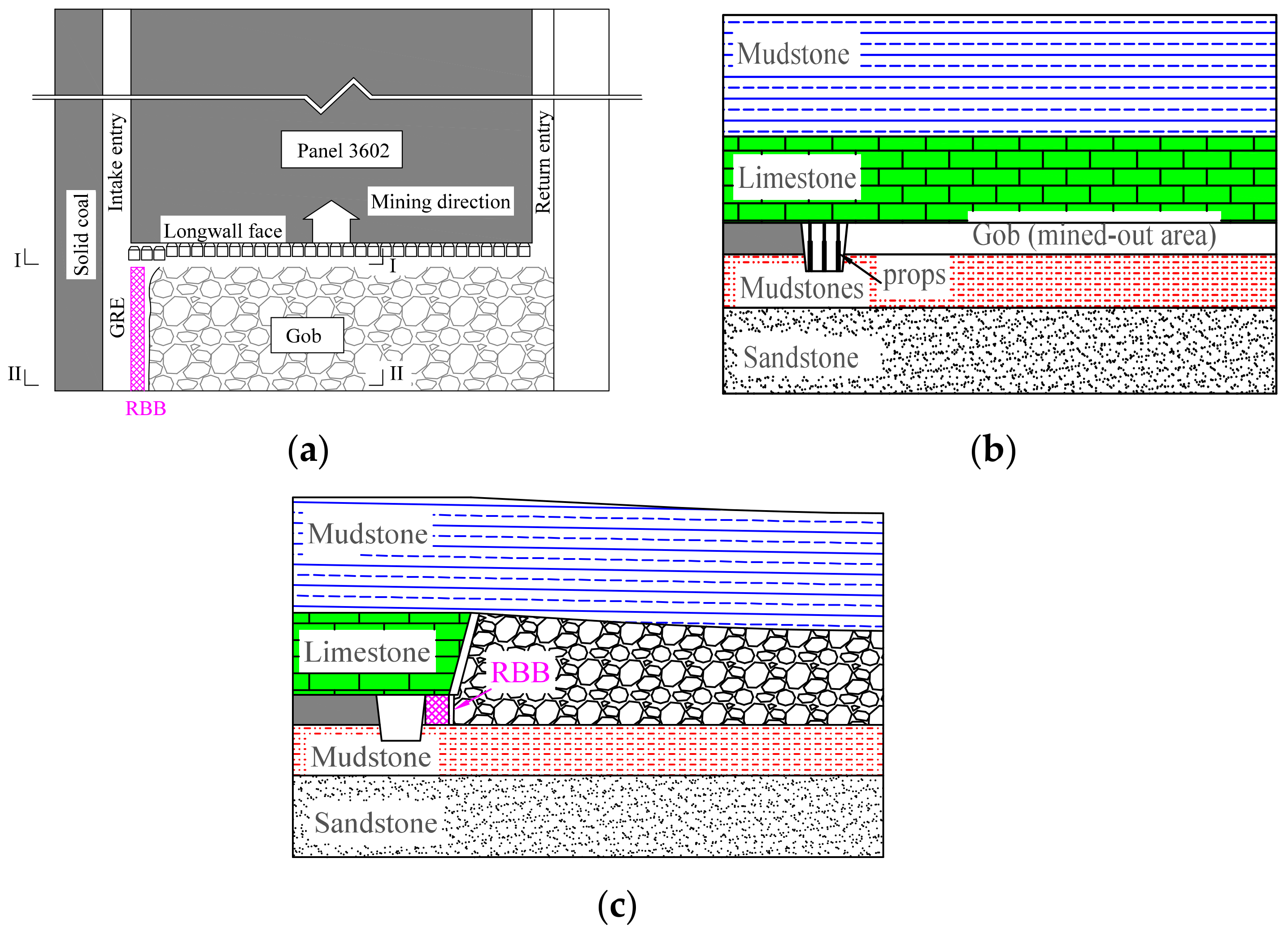
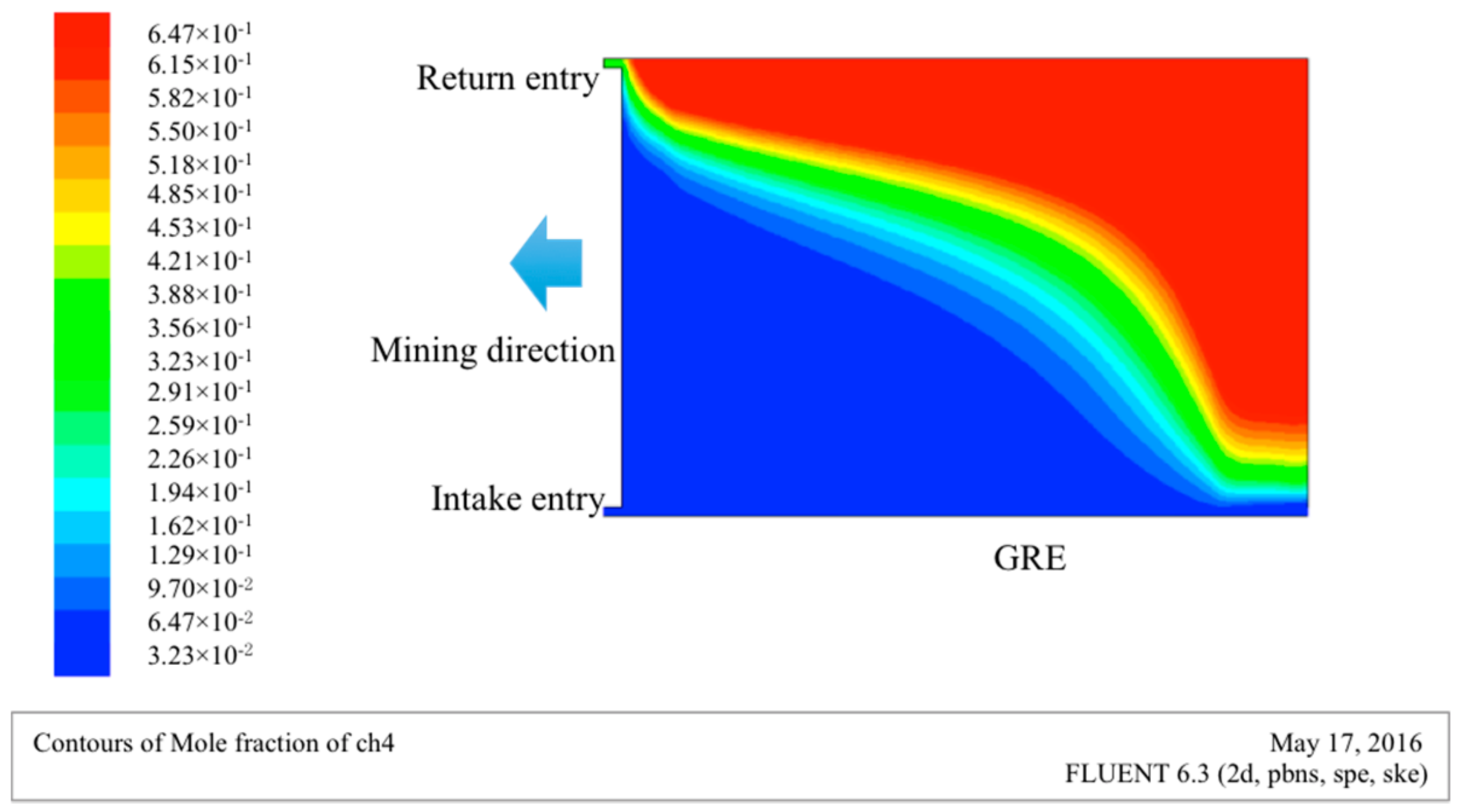

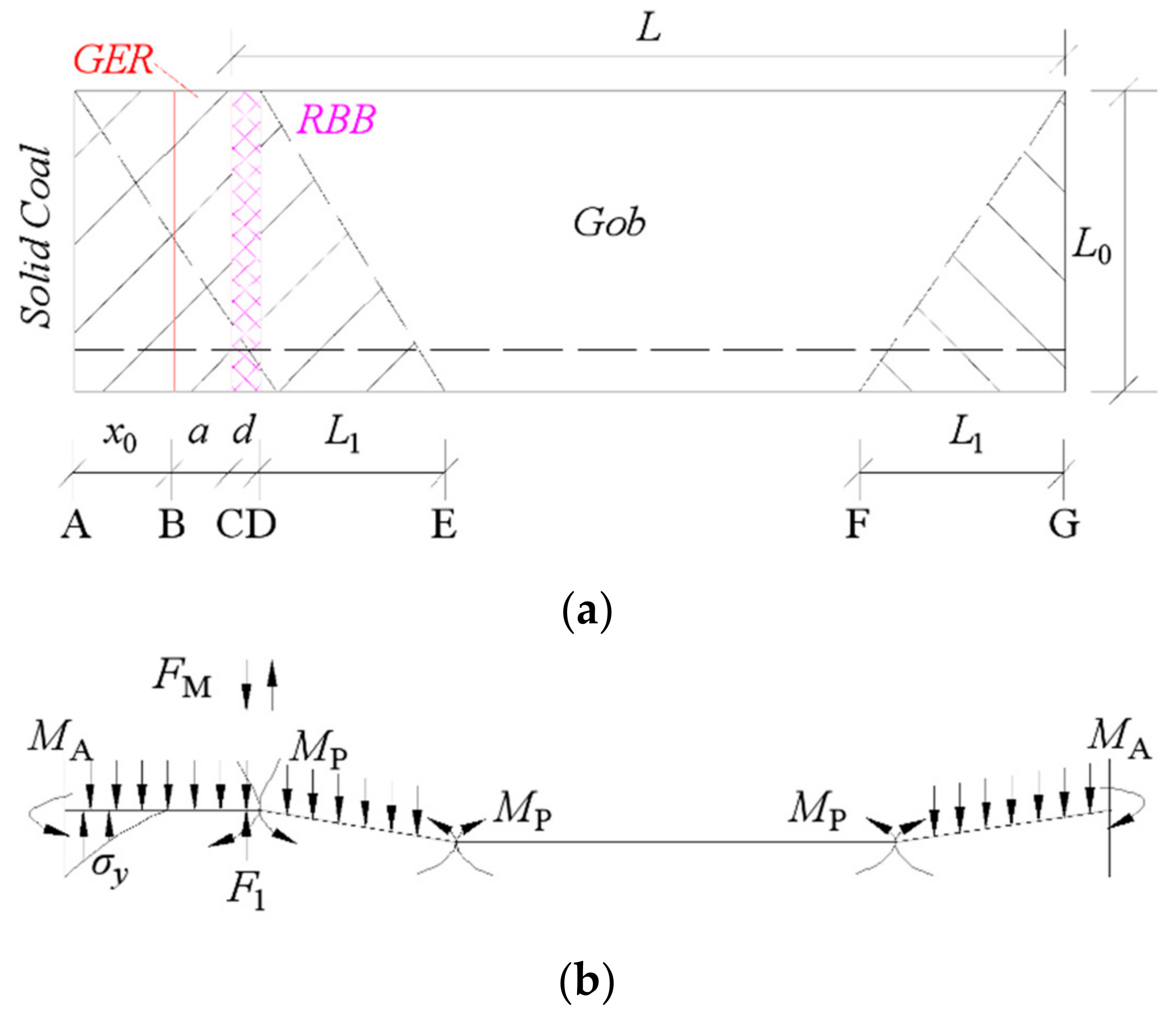
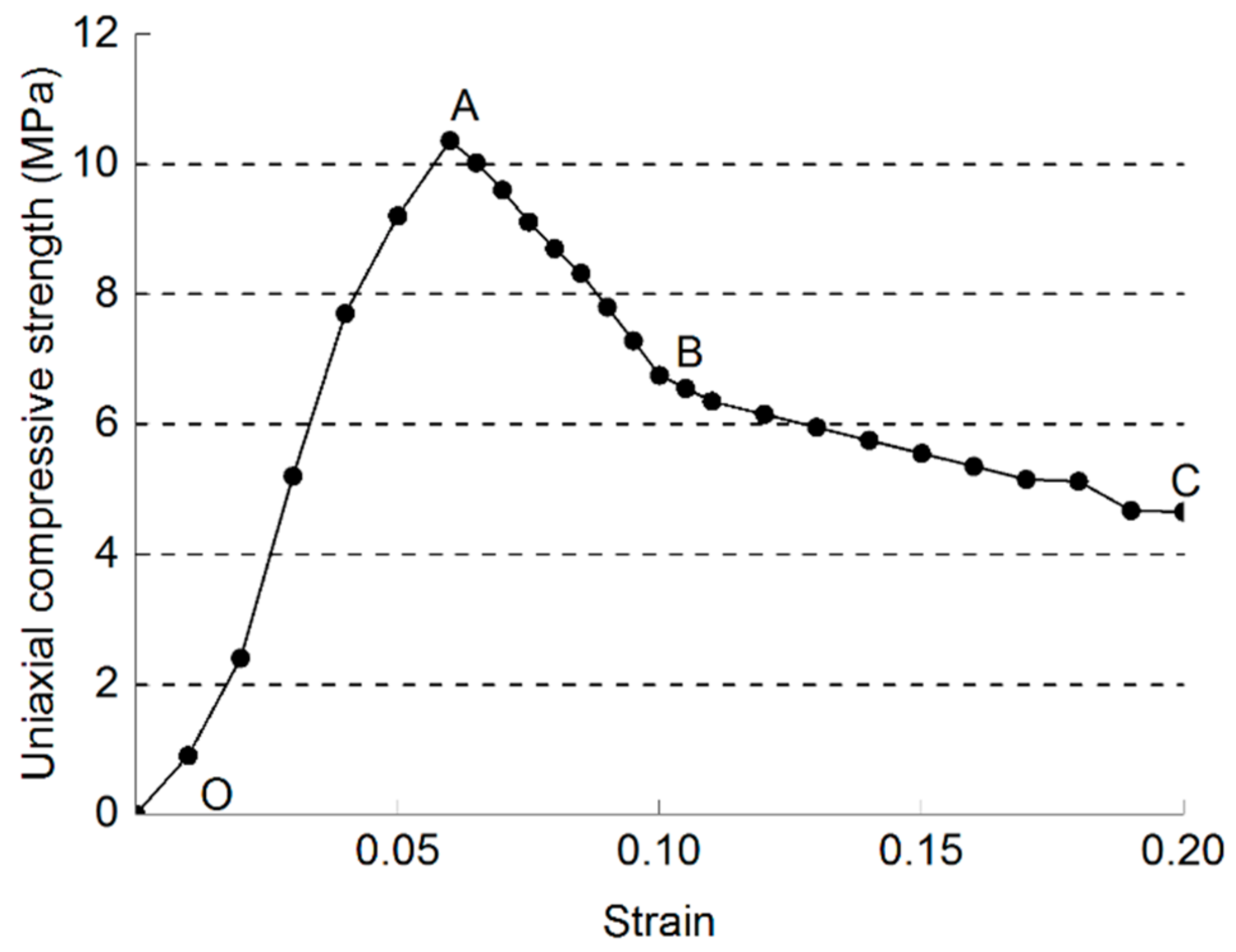

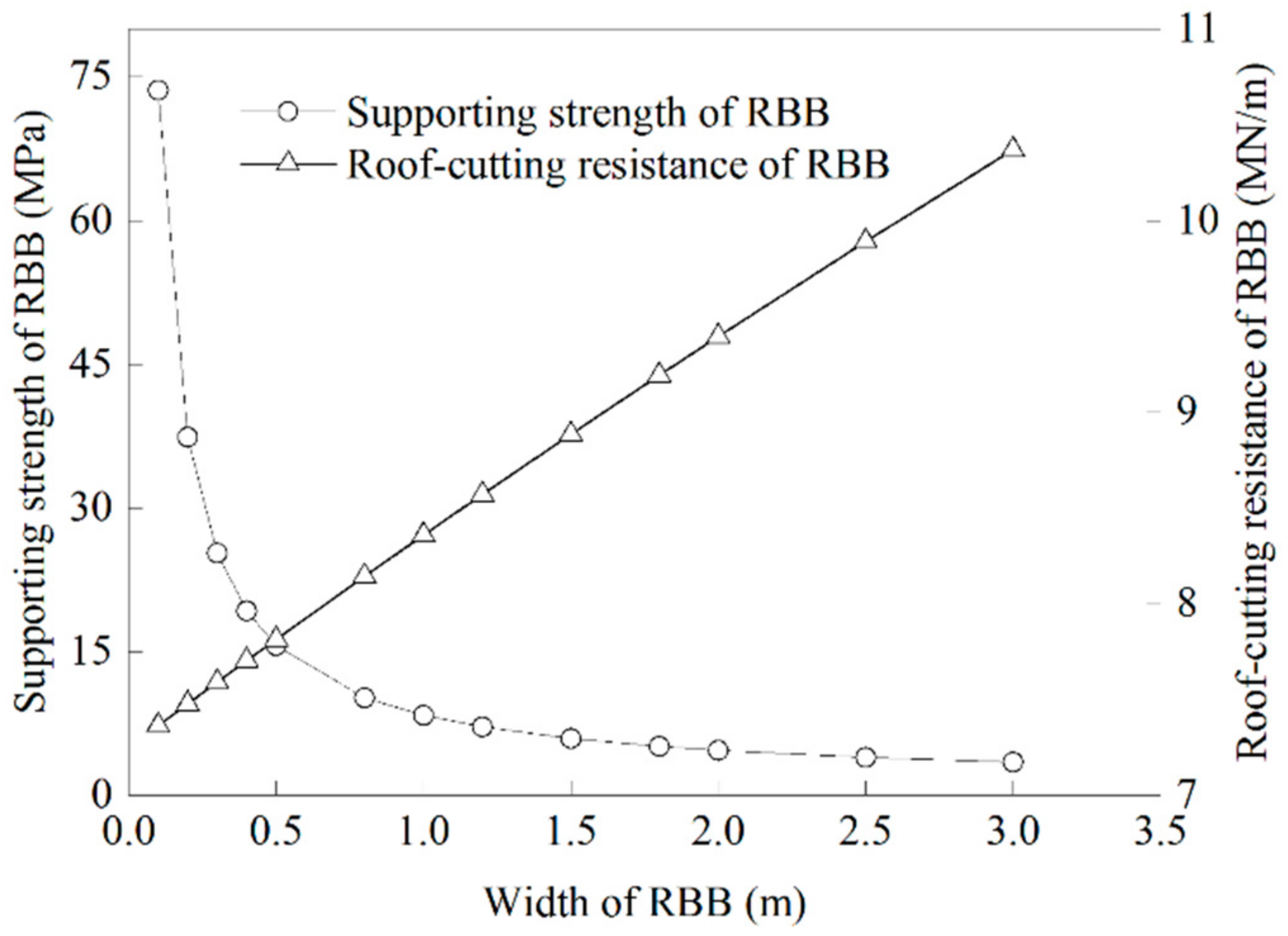





| Name | Lithology | Thickness (m) | Lithological Description |
|---|---|---|---|
| Main roof | Mudstone | 6.4 | Light grey, with mudstone and siltstone stripe |
| Immediate roof | Limestone | 5.0 | Dense hard, rich fracture |
| Coal bed | Coal | 0.9 | |
| Immediate floor | Aluminous mudstones | 2.1 | Light grey, water expand |
| Main floor | Sandstone | 5.0 | Grey with horizontal bedding |
| Rock Strata | Thickness (m) | Denstity (kg/m3) | Bulk Modulus (GPa) | Shear Modulus (GPa) | Cohesion (MPa) | Friction Angle (°) |
|---|---|---|---|---|---|---|
| Underlying strata | 12 | 2500 | 10.0 | 7.6 | 5.2 | 41 |
| Siltstone | 2.1 | 2550 | 8.8 | 6.3 | 4.0 | 38 |
| Aluminum mudstone | 1 | 1800 | 5.2 | 4.0 | 2.5 | 25 |
| No. 16-2 coal seam | 0.5 | 1400 | 4.3 | 2.7 | 1.6 | 23 |
| Sandstone | 5 | 2650 | 3.5 | 2.1 | 1.0 | 17 |
| Aluminum mudstone | 2.1 | 1700 | 4.2 | 2.4 | 2.2 | 25 |
| No. 16-1 coal seam | 0.9 | 1400 | 3.0 | 1.5 | 1.4 | 21 |
| Limestone | 5 | 2900 | 9.7 | 7.1 | 5.2 | 36 |
| Mudstone | 6.4 | 1800 | 4.3 | 2.2 | 1.5 | 28 |
| Overlying strata | 17 | 2500 | 8.9 | 6.2 | 3.2 | 32 |
| Properties | Values | Properties | Values |
|---|---|---|---|
| Bulk modulus (GPa) | 2.9 | K shear (GPa) | 1.6 |
| Shear modulus (GPa) | 1.3 | Kviscosity (GPa) | 3.0 |
| Cohesion (MPa) | 3.2 | Mshear (GPa) | 2.2 |
| Internal friction angle (°) | 32 | Mviscosity (GPa) | 2.4 |
© 2018 by the authors. Licensee MDPI, Basel, Switzerland. This article is an open access article distributed under the terms and conditions of the Creative Commons Attribution (CC BY) license (http://creativecommons.org/licenses/by/4.0/).
Share and Cite
Yan, S.; Liu, T.; Bai, J.; Wu, W. Key Parameters of Gob-Side Entry Retaining in A Gassy and Thin Coal Seam with Hard Roof. Processes 2018, 6, 51. https://doi.org/10.3390/pr6050051
Yan S, Liu T, Bai J, Wu W. Key Parameters of Gob-Side Entry Retaining in A Gassy and Thin Coal Seam with Hard Roof. Processes. 2018; 6(5):51. https://doi.org/10.3390/pr6050051
Chicago/Turabian StyleYan, Shuai, Tianxiao Liu, Jianbiao Bai, and Wenda Wu. 2018. "Key Parameters of Gob-Side Entry Retaining in A Gassy and Thin Coal Seam with Hard Roof" Processes 6, no. 5: 51. https://doi.org/10.3390/pr6050051





